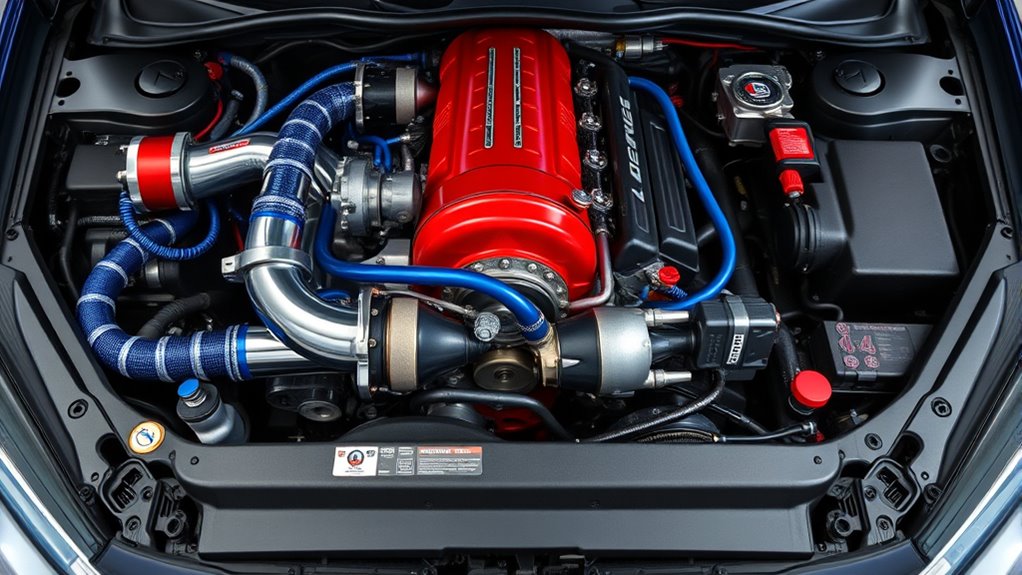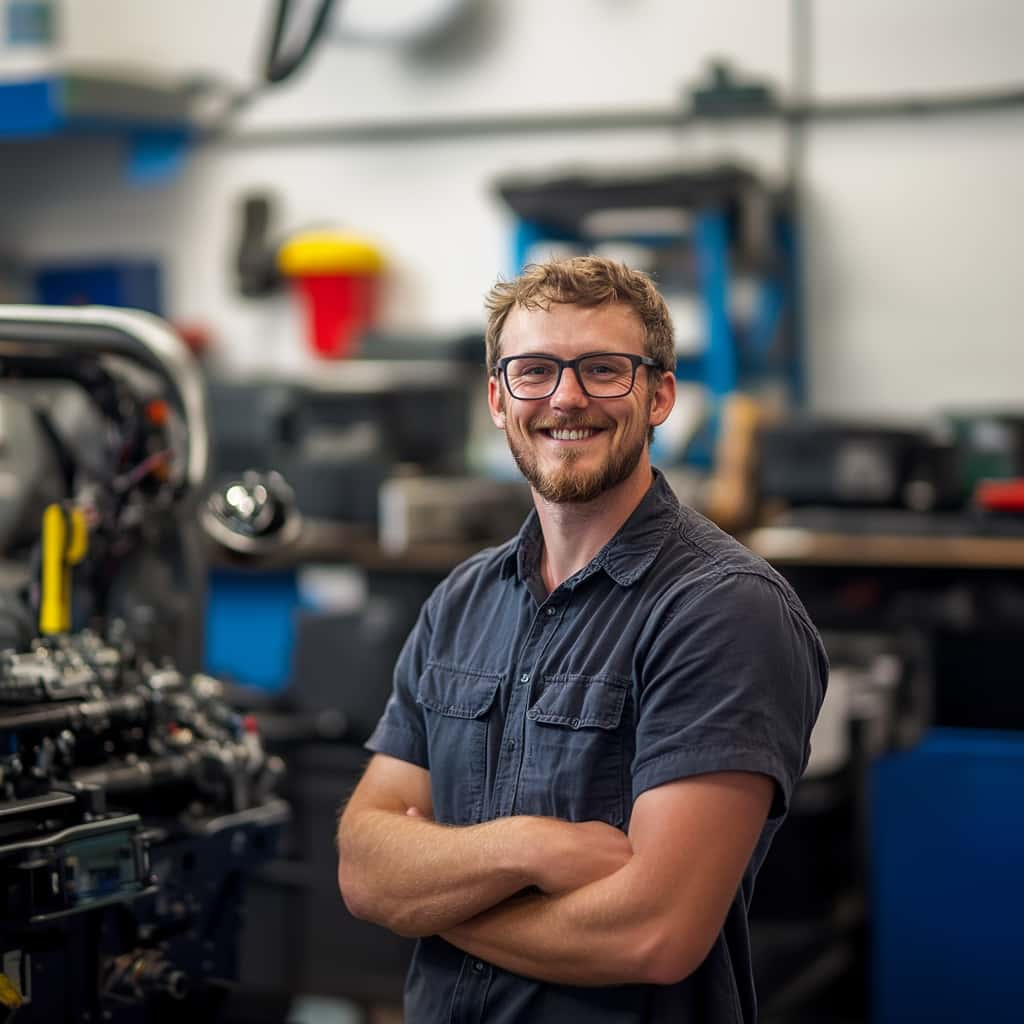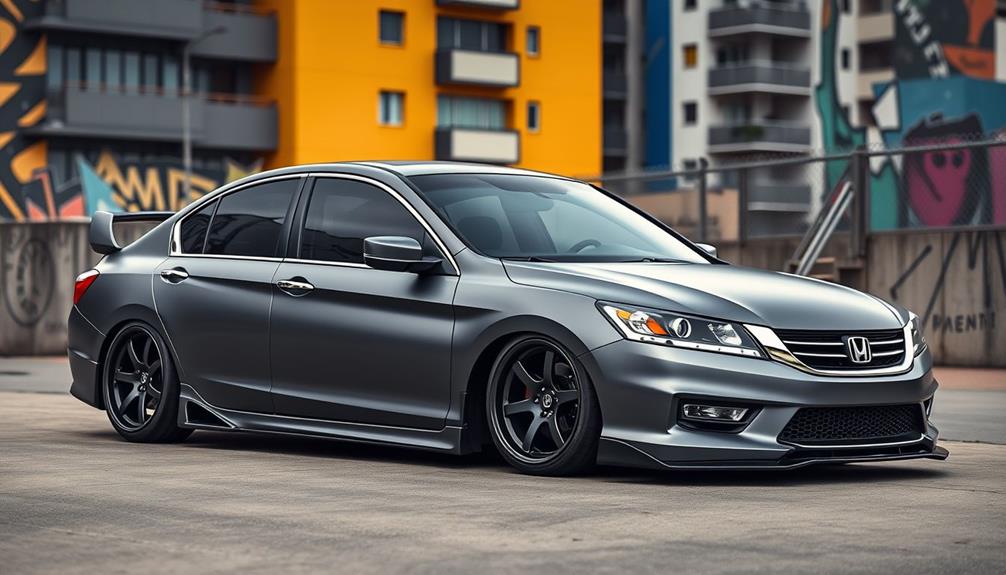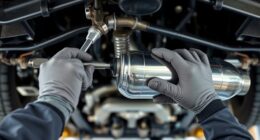When swapping a J35 turbo into your Civic, focus on a large, efficient intercooler to keep intake temps low and avoid heat soak. Proper boost management with a tuned ECU prevents engine damage, while reinforcing your drivetrain components like the clutch and axles handles the increased power reliably. Upgrading cooling and oil systems helps prevent overheating. Keep these tips in mind, and you’ll build a dependable, high-performance Civic—more detailed advice is right around the corner.
Key Takeaways
- Use a large, high-quality front-mount intercooler with proper piping for maximum cooling efficiency.
- Properly tune boost pressure with a custom ECU or piggyback system to prevent engine knocking.
- Reinforce driveline components like clutch, axles, and driveshaft to handle increased torque from the turbo.
- Upgrade cooling systems, including radiator, fans, and oil catch cans, to manage higher heat levels.
- Ensure tight, leak-free connections in all intercooler and boost plumbing for consistent performance.

If you’re looking to remarkably boost your Honda Civic’s performance, swapping in a J35 engine with a turbo setup is a powerful upgrade worth contemplating. One of the key aspects to unlocking its full potential is managing the turbo boost effectively while ensuring your cooling system keeps everything running smoothly. The turbo boost increases air pressure going into the engine, which boosts power, but it also generates more heat. Without proper cooling, this extra heat can lead to knocking, reduced performance, or even engine damage. That’s where an efficient intercooler setup becomes essential. An intercooler cools the compressed air from the turbo, making it denser and more oxygen-rich before it enters the combustion chamber. This not only helps maintain optimal power output but also improves engine reliability and longevity. When selecting an intercooler, focus on one with a large core size and good airflow characteristics to maximize cooling efficiency. Proper placement is vital—mount it where it can get the most airflow, typically front-mounted, and ensure all connections are tight to prevent leaks.
Proper intercooler setup is essential for optimal turbocharged Honda Civic performance and engine longevity.
Beyond cooling, you need to consider the driveline to handle the increased power. Upgrading the clutch and flywheel is a smart move, as the stock components might slip or wear out faster under the added stress of a turbocharged J35. A heavy-duty clutch can provide better grip and durability, especially if you plan on pushing the power even further with tuning. Also, reinforce your driveshaft and axles if necessary to handle the higher torque levels. These upgrades help translate the increased engine power into smooth, reliable acceleration without risking drivetrain failure.
Tuning the engine management system is another critical step. Proper tuning ensures the turbo boost pressure is balanced with fuel delivery and ignition timing, preventing knocking and maximizing power. A custom ECU tune or piggyback system allows you to fine-tune these parameters, especially important for maintaining safety margins while enjoying boosted performance.
Finally, pay attention to oil and cooling systems. A turbocharged J35 produces more heat, so upgrading to high-quality synthetic oil and considering an oil catch can can help manage oil temperatures and reduce buildup. A good radiator upgrade, combined with an efficient cooling fan setup, ensures your engine stays within safe operating temperatures during spirited drives or long, hot days. By focusing on a robust intercooler setup, managing turbo boost carefully, and reinforcing your driveline, you’ll create a reliable, high-performance Civic that’s ready to take full advantage of your J35 turbo swap.
Frequently Asked Questions
What Are the Best Aftermarket Cooling Upgrades for a J35 Turbo Civic?
To improve cooling for your turbocharged J35 Civic, focus on aftermarket upgrades that maximize airflow and coolant routing. Upgrade to an aftermarket radiator with better core design, and consider a high-flow fan to boost airflow. Install an oil cooler to help manage engine temps, and reroute coolant hoses for ideal flow. These upgrades keep your engine running cool, prevent overheating, and guarantee consistent performance under boost conditions.
How Can I Improve Driveline Durability After the Turbo Swap?
To improve driveline durability, you should focus on driveline reinforcement and axle upgrades. Reinforce your transmission mounts and consider upgrading your axles to stronger, high-performance versions that can handle increased torque. This helps prevent breakage and guarantees smooth power transfer. Regularly inspect your drivetrain components for wear, and consider upgrading your differential if you’re pushing your turbocharged setup hard. These steps will keep your Civic reliable and responsive.
Are There Specific Oil Cooler Recommendations for High-Performance Turbo Applications?
For high-performance turbo applications, you should choose an oil cooler designed for increased oil capacity and efficient heat dissipation. Look for a unit with a larger surface area and proper fittings to match your engine’s needs. Upgrading your oil cooler helps prevent overheating, especially under heavy boost. Verify it’s compatible with your vehicle’s existing oil system, and consider adding a thermostat to regulate oil temperature during all driving conditions.
What Transmission Modifications Are Necessary for the J35 Turbo Swap?
When upgrading your transmission for the J35 turbo swap, you should consider a transmission upgrade to handle increased power and torque. Reinforcing the clutch is essential; opt for a high-performance clutch that can withstand turbocharged engine stress. You might also need a stronger flywheel and possibly a shift kit for smoother engagement. These modifications guarantee your driveline remains reliable and responsive under the added performance demands.
How Do I Prevent Heat Soak in the Intercooler During Extended Driving?
To prevent heat soak in your intercooler during extended drives, focus on proper intercooler placement—mount it where airflow is ideal. Install a heat shield around the intercooler to block engine heat, keeping intake temps lower. Consider adding an electric fan to improve cooling when the car’s stationary or moving slowly. These steps help maintain consistent power and prevent performance drops caused by heat soak.
Conclusion
Think of your Civic as a finely tuned orchestra, and the J35 turbo swap as the new, powerful conductor. With proper cooling and driveline tuning, you’ll guarantee every instrument plays harmoniously, avoiding discord or burnout. When you respect each component’s role—like a conductor respecting every musician—you create a performance that’s both powerful and reliable. Embrace this journey with patience and precision, and your Civic will sing a symphony of speed and durability for miles to come.










